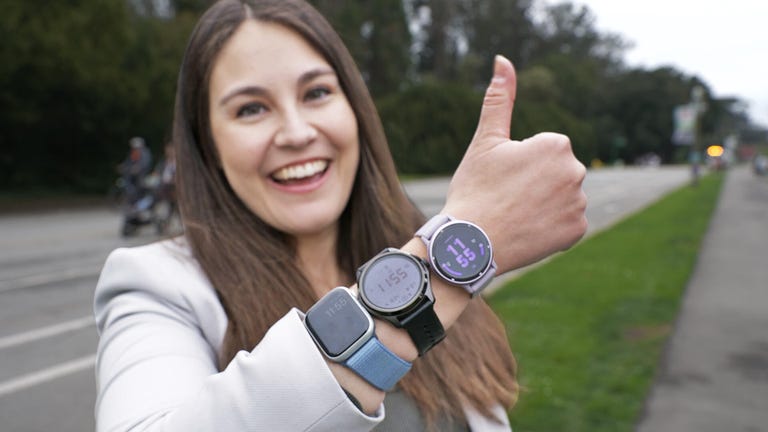Google-owned Fitbit thinks there’s big potential for AI to help people set more realistic health aspirations.
Anyone who exercises regularly — or at least tries to — knows that every day is different. After an exhausting work trip, for example, you probably aren’t as ready for a workout as you would be after getting plenty of sleep over the weekend. Or perhaps you had a particularly intense day at the gym on Monday and still aren’t fully recovered by Wednesday.
Google’s Fitbit is hoping AI can help with scenarios like these as it explores bringing the buzzy technology to its fitness app. Fitbit co-founder James Park, who is leaving the company due to a reorganization of Google’s hardware division, introduced this idea October by announcing Fitbit Labs. The upcoming program will use AI to provide deeper health insights, such as answering questions about why your run may have been harder today than it was yesterday. But Ajay Surie, group product manager at Google, shared additional details about how generative AI will influence the Fitbit app more broadly.
Read more: Samsung’s Galaxy S24 Ultra Could Be Doing So Much More With AI
According to Surie, the company is looking at how generative AI can be used for providing personalized activity and exercise recommendations that are specific to the actual user. It’s another signal that tech giants are looking for ways to infuse generative AI, or AI that can answer questions or create content when prompted after being trained on data, into the tech gadgets we use everyday.
“We also see a huge potential for AI to help us drive the right recommendations for the goals you want to set,” he said. “Because one of the biggest problems that we see in health, and I have this problem too, is getting users to stay focused and sticking with what they’re trying to achieve.”

Surie referenced exercise goals as a potential example. The World Health Organization recommends that adults get 150 minutes of physical activity each week. But that can be challenging for those who are new to exercise, while experienced athletes may need a higher goal. He sees “huge potential” in AI to help set the right targets.
“We want to help people keep track of their goals and stay on track, but also adjust their goals where relevant,” he said.
Another possible example involves taking a user’s current state into account when making recommendations or providing advice. That would mean being able to tailor daily guidance based on the amount of sleep you’ve had recently or whether you’ve been sick. Or it could mean providing tips for maintaining a training regimen even when you’ve had a bad rest day. However, these are just examples meant to illustrate the types of features Fitbit hopes to eventually provide.
“Those are the types of things we’d like to do over time,” Surie said. “This is our vision, and it’s going to take time to get there.”
AI or Not AI: Can You Spot the Real Photos?



Part of why Fitbit redesigned its app last year was to set the stage for Fitbit Labs by making the app more customizable and personal. The Today tab, for example, now has a specific “focus,” which is essentially a group of statistics that sit near the top of the screen for prioritizing specific goals, like being more active or sleeping better.
But many longtime Fitbit users felt the redesign hampered rather than helped their fitness ambitions. Following the new app’s debut in the fall, Fitbit’s community forums were filled with negative comments from users about how the new look made it hard to find certain metrics or export data among other issues. Fitbit also removed beloved social features like challenges and groups last year.
Fitbit addressed certain complaints by re-adding some missing features, like the battery percentage for a connected Fitbit device in the Today tab and step streak counts in the iOS app. But new user complaints are still surfacing, with comments as recent as early February present in the Fitbit community forum at the time of writing.
“The process the team followed was, we wanted to really react as quickly as we could,” Surie said when asked about how the Fitbit team handled the feedback about the redesign. “So we engage quite heavily with the community of users in our forums to sort of listen to their feedback, try to give them a sense of what we were going to do and then follow up as quickly as we could in terms of getting things turned around.”
Fitbit’s ambitions are another sign that generative AI is making its way to health tracking gadgets, following the technology’s influence on smartphones, productivity software and search engines. Apple, for example, is rumored to be developing an AI-powered health coach that could provide suggestions based on Apple Watch data, according to Bloomberg. Samsung is also considering creating some type of virtual assistant that can help users navigate health data in the Samsung Health app.
“We think the concept of a digital system that helps you to navigate and understand the context and navigate them to solutions are going to be necessary,” Hon Pak, vice president and head of the digital health team for the mobile experience business at Samsung Electronics, said in a previous CNET interview. “And what form factor that’s going to be is to be determined. And it may vary based on person to person, right? Some people just probably want audio; some people want a video on the TV.”
Fitbit Labs will be available only for Premium subscribers when it eventually launches in 2024. Surie couldn’t say whether that will always be the case, but he did mention that the company will evaluate which features should scale beyond the paywall on a case-by-case basis. The goal behind Fitbit Labs is to test certain features and collect feedback from users before rolling them out widely, potentially providing a glimpse into Fitbit’s future.
“Throughout this, we obviously want to make sure that we do this responsibly, especially in the health space,” Surie said. “It’s one thing to go to Netflix and watch a bad movie. And it’s a totally other thing to get a recommendation that is relevant to health and get inaccurate advice.”


